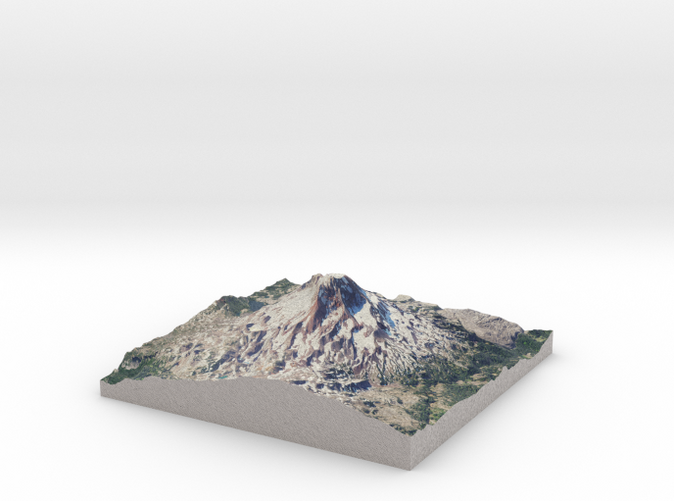Interactive 3D View
If you would like a custom relief map, contact me through my website or through Shapeways. Check out photos of my other 3D prints.
South Sister, also known as "Charity", is the tallest volcano of the trio, standing at 10,363 feet (3,159 m).
[1] The eruptive products range from basaltic andesite to rhyolite and rhyodacite.
[48][56] It is a predominantly rhyolitic stratovolcano overlying an older shield structure.
[44][57] Its modern structure is no more than 50,000 years old,
[44][58] and it last erupted about 2,000 years ago.
[8] Although its first eruptive events from 50,000 to 30,000 years ago were predominantly rhyolitic, between 38,000 and 32,000 years ago the volcano began to alternate between dacitic/rhyodacitic and rhyolitic eruptions. The volcano built a broad andesitic cone, forming a steep summit cone of andesite about 27,000 years ago. South Sister remained dormant for 15,000 years, after which its composition shifted from dacitic to more rhyolitic lava.
[52] An eruptive episode about 2,200 years ago, termed the Rock Mesa eruptive cycle, first spread
volcanic ash from flank vents from the south and southwest flanks, followed by a thick rhyolite lava flow. Next, the Devils Hill eruptive cycle consisted of explosive ash eruptions followed by viscous rhyolitic lava flows.
[52] Unlike the previous eruptive period, it was caused by the intrusion of a dike of new silicic magma that erupted from 20 vents on the southeast side and from a smaller line on the north side.
[59] These eruptions generated pyroclastic flows and
lava domes from vents on the northern, southern, eastern, and southeastern sides of the volcano.
[60] These relatively recent, postglacial eruptions suggest the presence of a silicic magma reservoir under South Sister, one that could perhaps lead to future eruptions.
Source: Wikipedia
The model is created at a scale of 1:50,000 with 1.5x vertical exaggeration. It features a built-in base, so it sits perfectly on a desk or in a frame.
Model Data Sources: US Department of Agriculture (Imagery), US Geological Survey (Elevation)
